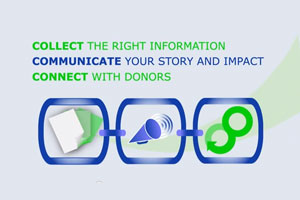Right on the Money: A New Report Advises Charities to Share Their Successes With Potential Donors
 A couple of years ago, we reported on “Money for Good,” a study that asked donors why they give to charity and, based on their answers, divided them into six categories. Hope Consulting, the San Francisco company that conducted the study, found that some people give money out of feelings of religious obligation. Other people want to give to causes that don’t get enough attention. Still others give as a way to “pay back” institutions that have helped them, like an alma mater or a social service group. (Learn more about all six categories.)
A couple of years ago, we reported on “Money for Good,” a study that asked donors why they give to charity and, based on their answers, divided them into six categories. Hope Consulting, the San Francisco company that conducted the study, found that some people give money out of feelings of religious obligation. Other people want to give to causes that don’t get enough attention. Still others give as a way to “pay back” institutions that have helped them, like an alma mater or a social service group. (Learn more about all six categories.)
To learn more about the types of information donors want and how they want to get it, Hope Consulting teamed up with Guidestar, a charity that collects and shares information about the nonprofit sector. Their follow-up report, “More Money for More Good,” contends that individual donors and foundation officers alike want to know five things:
- The financial picture, including how an organization spends its money
- That a nonprofit is legitimate
- The basics of the organization—its mission, approach, and make up
- The breadth and depth of the cause
- The nonprofit’s impact
The first four things, the authors say, are easy for donors to come by. The fifth—the real-world difference charities are making—is something people want to hear more about.
“More Money for More Good” goes on to explain what nonprofits can do to describe their impact. We recommend reading the full report, but here are a few tidbits of advice from Lindsay Nichols, spokesperson for Guidestar:
Share meaningful statistics. How many people did you help? How are you measuring your progress? “I don’t think donors care about the number of numbers,” Nichols says. “They want to see that there’s a number.”
Paint a picture of your impact. Tell stories about the people you help. Change names and details to protect confidentiality if you have to, Nichols says. The important thing is to show how you change real people’s lives: “We helped Charlotte through our financial literacy workshop.”
Highlight accolades from others. Put stars from rating services like Charity Navigator and reviews from sites like Great Nonprofits, Guidestar’s Philanthropedia, and Yelp right on your home page.
“If you’re reviewed by them, you should most definitely shout that from the rooftops,” Nichols says. “So it’s not just you talking about how good you are, it’s other people. That gets people to trust you”—and hopefully, make a donation to your cause.
Read More
“Money for Good” (2010)
NCFY’s article about “Money for Good”
“More Money for More Good” (2012)


 Sign up
Sign up Follow us
Follow us Like us
Like us Sign up for our RSS feeds:
Sign up for our RSS feeds: 

